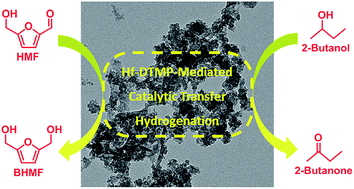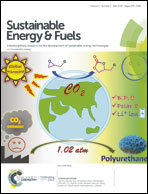Highly selective hydrogenation of biomass-derived 5-hydroxymethylfurfural into 2,5-bis(hydroxymethyl)furan over an acid–base bifunctional hafnium-based coordination polymer catalyst†
Abstract
The catalytic transfer hydrogenation (CTH) pathway is a promising and appealing method for the selective hydrogenation of biomass-derived 5-hydroxymethylfurfural (HMF) into 2,5-bis(hydroxymethyl)furan (BHMF) via the Meerwein–Ponndorf–Verley (MPV) reaction, in which the development of effective and economical catalysts is of great significance. Herein, this work designed and prepared a new hafnium-based metal–organic coordination polymer (Hf-DTMP) by the simple assembly of hafnium tetrachloride (HfCl4) and diethylene triaminepenta(methylene phosphonic acid) (DTMP). Comprehensive studies demonstrated that Hf-DTMP is an amorphous and mesoporous catalyst with a strong acid–base bifunctionality, and so, it displayed excellent catalytic activity for the CTH of HMF into BHMF with a high yield of 96.8% in 2-butanol (sBuOH) at a moderate reaction temperature of 130 °C for 4 h. In addition, Hf-DTMP exhibited good heterogeneity, reusability and stability, and it could be easily recovered from the reaction mixture by filtration and consecutively used for at least 5 recycles without a dramatic loss in catalytic activity. More gratifyingly, Hf-DTMP also showed superior universality for the CTH of 5-methylfurfural (MF), furfural (FF), levulinic acid (LA), ethyl levulinate (EL) and cyclohexanone (CHN) into the corresponding products with high yields, obviously indicating that it has tremendous potential for the selective hydrogenation of various biomass-derived carbonyl compounds.

- This article is part of the themed collection: 2019 Sustainable Energy and Fuels HOT Articles


 Please wait while we load your content...
Please wait while we load your content...